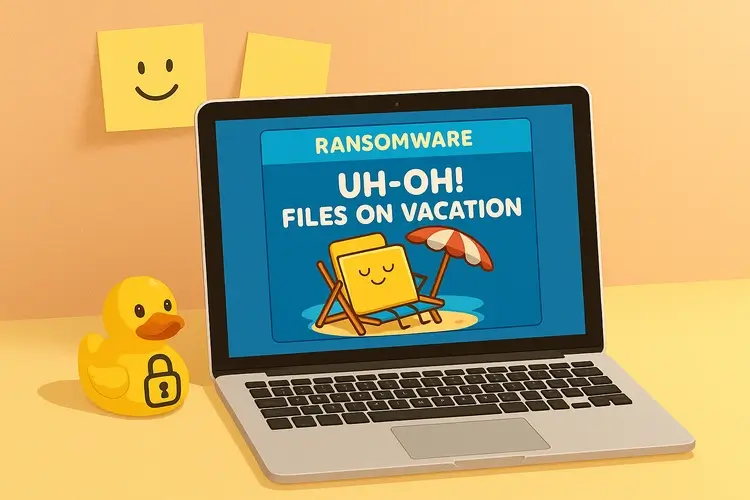Ransomware 2.0: From Encrypting Files to Shutting Down Society
Updated on November 12, 2025 5 minutes read

Ransomware has grown up. It no longer just locks files. Modern ransomware can stop hospitals, schools, and city services. It can leak private data and pause a business for days.
This guide explains what changed, how attacks happen, and how to defend against them.
What Changed: From Locking Files to Leverage
Double (and Triple) Extortion
Old ransomware encrypted your files and asked for money. You could restore from backups and move on.
Ransomware 2.0 adds double extortion: attackers steal sensitive data before they encrypt it. If you refuse to pay, they threaten to publish or sell it. Some groups use triple extortion: they also DDoS (overwhelm your website) or contact your customers and partners to add pressure.
Ransomware-as-a-Service (RaaS)
You no longer need to be a top hacker to launch an attack. RaaS groups build tools and playbooks, then rent them to affiliates for a cut of the ransom. This lowers the barrier and increases the number of attackers.
How Attacks Happen
Attackers usually follow a similar path, and if you understand it, you can interrupt it. First, they find a way into the network. They might send a phishing email with a bad link or attachment, use stolen or weak passwords (especially when there is no MFA), or break in through exposed services like remote desktop, VPN, or old web applications. Once inside, they try to stay hidden and build a base. They may run a loader or backdoor, turn off or avoid basic antivirus, and quietly explore the network to see what systems and data exist. Next, they try to gain more power and move around. They steal admin credentials using things like keylogging or dumping memory, then move to important systems such as servers, backup systems, or domain controllers. After that, they focus on stealing data. They often zip and encrypt sensitive files, then send that data out to storage they control. Finally, they go for impact. They encrypt key systems and backups, leave a ransom note, and often threaten to leak the stolen data or launch a DDoS attack if they are not paid.
Real-World Impact: Why Downtime Hurts

A single ransomware attack can stop a business from working normally for days or even weeks. It can delay important services like ambulances, school classes, salary payments, or customer deliveries. It can expose sensitive data such as customer details, contracts, or health records. It also makes everything more expensive because you have to spend time rebuilding systems, lose revenue while things are down, pay for legal help, deal with compliance issues, and repair your reputation. In most cases, the downtime and cleanup end up costing more than the ransom itself.
Defenses That Work Today
You don’t need a giant budget. You need layers that make each attack step harder.

1) Multi-Factor Authentication (MFA)
- Turn on MFA everywhere, especially for email, VPN, admin accounts, and critical apps. Prefer phishing-resistant methods (hardware keys, passkeys, or app-based prompts).
2) Patch and Reduce Attack Surface
- Patch browsers, VPNs, and public-facing apps first
- Remove or lock down Remote Desktop Protocol (RDP) on the internet
- Use least privilege: users get only the access they need
3) Backups (Immutable + Tested)
- Keep offline or immutable backups
- Test restores often; a backup you can’t restore is not a backup
- Separate backup credentials from normal admin accounts
4) Network Segmentation
- Put crown-jewel systems (e.g., domain controller, billing, EMR) in separate segments
- If malware breaks into one zone, it shouldn’t roam free
- Control traffic between segments with allow-lists
5) EDR/XDR + Monitoring
- Use Endpoint Detection & Response (EDR) or XDR to spot abnormal behavior (mass encryption, unusual admin tools, lateral movement)
- Send logs to a central place; set alerts for high-risk actions
6) Strong Email and Web Controls
- Use email filtering and attachment sandboxing
- Block macro-enabled documents by default
- Use DNS filtering to stop known bad domains
7) Incident Response (IR) Plan and Drills
- Write a short IR plan: who to call, what to isolate, what to collect, how to communicate
- Run tabletop exercises twice a year
- Keep legal, PR, and leadership in the loop
Careers in Cybersecurity: Skills You Can Learn
Ransomware defense needs people, not just tools. Entry roles include:
- SOC Analyst (Tier 1): Monitor alerts, triage events, escalate fast
- Incident Responder: Contain threats, collect evidence, guide recovery
- Threat Hunter: Proactively search for attacker activity early
- Security Engineer: Harden endpoints, manage EDR/XDR, secure configs
At Code Labs Academy, our Cybersecurity Bootcamp covers:
- Network basics, Windows/Linux internals, and Active Directory
- EDR hands-on labs and alert triage
- Threat modeling, phishing testing, and email security
- IR planning, tabletop drills, and post-incident reviews
Explore programs or enroll: Code Labs Academy Cybersecurity Bootcamp
You can build real skills in months, not years, with guided, practical training.
Ready to Step In? Join a Community That Practices
If you’re still early in your cybersecurity journey, focus on skills you can use again and again. Learn how to spot a phishing attempt. Learn how to read an EDR alert and know how to respond to it. Practice isolating an affected computer and collecting basic forensic data from it. Learn how to restore a system from a backup when something goes wrong. Also get comfortable giving a short, simple report after an incident, using plain language that non-technical people can understand. We train you on these skills through hands-on labs and projects, so you can show employers real work you’ve done. You can get started by checking out our curriculum and upcoming sessions.
We teach these skills in labs and projects so you can show employers real work. Start by exploring our curriculum and upcoming sessions.
Check out our cybersecurity program:
https://codelabsacademy.com/en/courses/cybersecurity/

